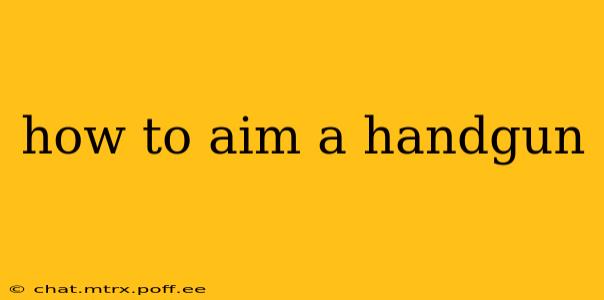For responsible gun owners, mastering proper handgun aiming techniques is crucial for safety and accuracy. This guide provides a comprehensive overview, covering fundamental aiming principles and addressing common questions. Remember, safe gun handling practices should always be prioritized. Consult a qualified firearms instructor for personalized training.
What are the basic steps to aiming a handgun?
The process of aiming a handgun involves a sequence of steps that, when practiced consistently, will significantly improve your accuracy. These steps include:
-
The Stance: Adopt a stable and comfortable stance. This could be an isosceles stance (feet shoulder-width apart, arms extended), a weaver stance (similar to the isosceles but with a staggered foot placement), or a modified weaver, which is a more relaxed version. Experiment to find what works best for you. A solid stance prevents unnecessary movement and keeps the gun stable.
-
The Grip: A firm but relaxed grip is essential. Too tight a grip can lead to fatigue and inaccuracy, while too loose a grip compromises control. The grip should be high on the backstrap of the gun, allowing for consistent recoil management.
-
The Sight Picture: This is where the magic happens. Proper sight alignment is crucial. You should see the front sight clearly, centered in the rear sight notch, with both sights aligned with the target. Focus intently on the front sight.
-
The Sight Alignment: This is the crucial step for accurate shooting. Ensure the front sight is perfectly centered within the rear sight's notch. The top of the front sight should be level with the top of the rear sight.
-
Breathing: Control your breathing. Take a deep breath, exhale halfway, and hold your breath while you take the shot. This helps to minimize movement and ensure a steady aim.
-
Trigger Control: This is arguably the most important element of accurate shooting. Slowly and smoothly squeeze the trigger straight back, avoiding any jerking or anticipation. The gun should go off as a natural extension of the trigger squeeze.
-
Follow-Through: After firing, maintain your sight picture and grip for a moment. This allows you to assess your shot and make any necessary adjustments.
What is the best way to hold a handgun for aiming?
The best way to hold a handgun involves a high, firm grip that encompasses the entire grip of the weapon. You want your hand to be fully wrapped around the grip, avoiding any pinching or tension. Your shooting hand should be actively working with the gun, supporting the gun’s weight and controlling its recoil. Your support hand should add stability and control, naturally complementing the grip of your shooting hand. The precise grip will vary based on the size and design of your firearm, but consistency is key.
How do you improve your handgun aim?
Improving your handgun aim is an ongoing process. It requires consistent practice and attention to detail. Key aspects include:
-
Dry Firing: Practice your trigger control and sight alignment with an unloaded gun (always ensure it's completely unloaded and verified as safe). This allows you to work on the fundamentals without wasting ammunition.
-
Practice at the Range: Regular trips to the range are essential. Start with close-range targets, focusing on proper technique. Gradually increase the distance as your accuracy improves.
-
Professional Instruction: Consider taking lessons from a qualified firearms instructor. They can provide personalized feedback and correct any flaws in your technique.
-
Different Handgun Types: The size and weight of the handgun can influence aiming. Getting comfortable with different sizes and weights may improve your overall shooting proficiency.
How far can you accurately aim a handgun?
The accurate aiming distance of a handgun varies greatly depending on several factors: the caliber of the handgun, the type of ammunition used, the skill of the shooter, and the environmental conditions. While some highly skilled shooters may hit targets at remarkable distances, most recreational shooters will find consistent accuracy challenging beyond 25 yards. For self-defense, focus on accuracy within 7-21 yards.
What are some common mistakes when aiming a handgun?
Common mistakes include:
- Poor Stance: An unstable stance can lead to inaccuracy.
- Incorrect Grip: A weak or inconsistent grip results in loss of control and poor accuracy.
- Anticipating the Recoil: Jerking the trigger leads to missed shots.
- Focusing on the Target Instead of the Front Sight: The front sight should be your primary focus.
- Ignoring Breath Control: Breath holding or uncontrolled breathing affects stability.
Remember, safe gun handling is paramount. Always follow the four rules of gun safety, and never point a firearm at anything you don't intend to shoot. Consistent practice and professional instruction will significantly improve your accuracy and proficiency.
